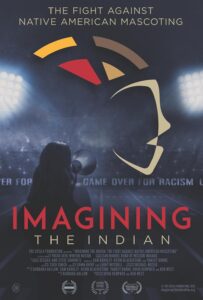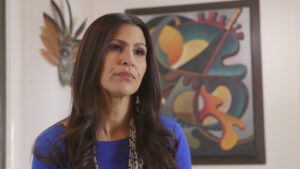Film Review: In Compelling “Imagining the Indian,” Native American Mascots Must Go
Written by: Christopher Llewellyn Reed | April 4th, 2023

Imagining the Indian: The Fight Against Native American Mascoting (Aviva Kempner/Ben West, 2021) 3 out of 4 stars.
Sports teams serve an important function in the modern world, sublimating societal aggression into something more benign than actual martial conflict. That’s the idea of their purpose, anyway, even if fans occasionally have other notions (I see you, European soccer enthusiasts). Within that universe, team mascots help rally the support of attendees, and we have all had experiences watching them lead rallies and more. It can be a lot of fun.
Most of them are animal in nature (my hometown has orioles and ravens, for example), but some, unfortunately, have long featured derogatory stereotypes of Native Americans. In the new documentary Imagining the Indian, directors Aviva Kempner (The Spy Behind Home Plate) and Ben West examine the horrible ways in which this continent’s indigenous population has been treated, not only within sports but throughout the history of colonization. It’s a bracing lesson in prejudice, as well as a story of resilience and survival.

The movie is filled with a great diversity of voices from throughout the indigenous community, each listed by name and tribe, from all walks of life. The historians among them remind us of the genocidal terrors of the past, providing detailed breakdowns of how the native population went from approximately 40 million when Columbus arrived to just 1 to 2 million by the 19th century. Cutting back and forth between these lessons and the present-day battles to remove mascots from amateur and professional sports teams, the movie makes a compelling—nay, irrefutable—case as to why no team, anywhere, should continue using names like “Redskins,” “Braves,” Indians,” and “Chiefs,” to name just some.
Fortunately, by the time Imagining the Indian ends, there have been changes, including that of the Washington, DC, football team’s name, though that one was eternally long in coming. The 2020 Black Lives Matter protests following the murder of George Floyd helped accelerate the renaming, given how activists joined forces to link all forms of racisms in one united front. After all, white supremacy harms anyone who will let it, so allies are important to defeat its scourge.

While the themes of the film are of enormous urgency, the aesthetics are hardly inspiring. We jump from interview to interview, then to archival footage (and some recent footage) and then back to interviews, none of which are photographed with particular style. Nevertheless, we are here for the compelling thesis of it all, plain visuals be damned. As a work of journalism, Imagining the Indian is riveting; as a work of cinema, perhaps less so. But it’s the former that seeps in beneath the skin, and any who soak in the moral of the tale will emerge energized to continue the fight to remove all indigenous mascots, forever.

